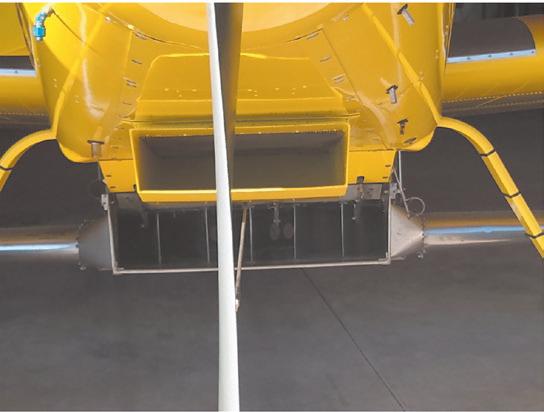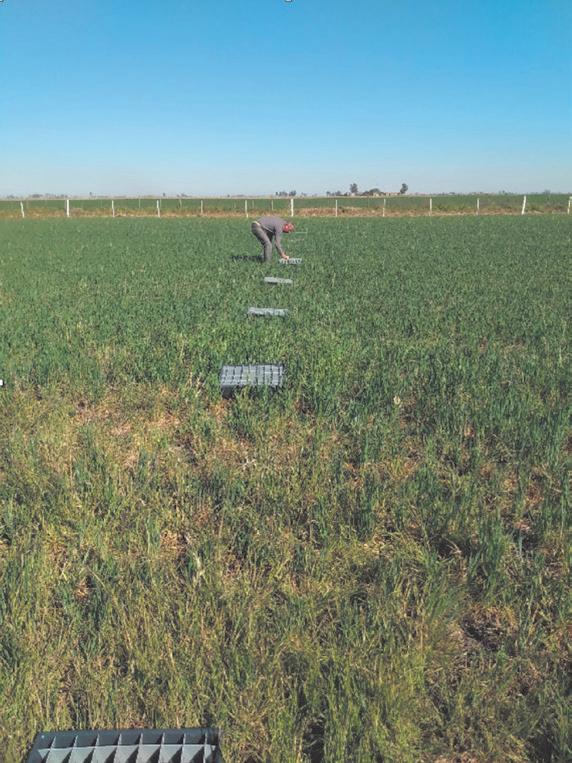
2 minute read
Planting Cover Crops
HANGAR CONVERSATIONS
Dr. Diego Martin Oliva | diegomartinoliva@gmail.com Agrônomo

Chart 1 (200 foot wheat) Swathmasters
1 Tray every 4 m
The season for the implantation of cover crops by air begins this fall for those operations north of the Equator. The use of the aircraft is essential for the success of cover crop planting and contributing to the sustainability of ag-aviation companies.
Aerial seeding is a strategic tool that must be strongly promoted due to its efficiency and operational capacity. Now, is all aerial seeding the same? Are the results always stable and predictable? Are the seed sizes and density always the same? For these and other queries, a group of companies that I advise in Argentina decided to take action on the matter. We set forth to find some answers.
The first problem we encountered was the need to standardize the evaluation of the results. After several discussions, we decided the best way was to make applications at different heights, (50-70-100-200 feet ) and always with a wind vector 0-180 °. This would be the most appropriate method to define, develop and evaluate a coefficient of variation (CV - standard deviation / series average) on a percentage scale.
At the same time, we had to take into account different solid dispersion systems (small gate box, large gate box or the high acceleration solid systems units like a Swathmaster). We needed to consider the characteristics of the solids; hectoliter weight (weight by volume), seed consistency and cleanliness, etc.
We had a huge technical challenge ahead of us, since the number of variables were adding up and not much time to accomplish our mission. So for now, we examined one or two of the variables at stake to define an accurate application.
With the first series of tests, we analyzed the distribution of a seed with good hectoliter weight, such as wheat. The seeds were applied on an analysis site 30 meters wide (98.4 feet) with a tailwind vector between 0-180°. The aircraft was an AT-502 fitted with a Swathmaster spreader, applied at 200 feet high. ➤

An AT-502 with spreader attached.

Setting up seed collection trays, four feet apart for 30 meters.
Eight trays were set up equal distances of four meters apart. Each tray’s equivalent area was 0.3416 m2 (3.68 sq. ft).
The results obtained were the following:
Overall average 8.83 88 kg/ha
Swath average 9.15 91 kg/ha
CV Overall 20.36%
CV Swath 21.14%
The results allowed us to ensure at a certain flight height (200 feet) with an effective swath width not greater than 28 meters, it is highly probable to achieve solid distributions with a low CV (coefficient of variability of the order of 21.14%). This reinforces the efficiency and accuracy of cover crop seeding using aerial applications.

Bottom Right: A collection tray with grids to manage the impact of the seeds.
Dr. Diego Martín Olivia, Curriculum vitae— Agronomist, specialist in extensive agricultural spraying, MBA Specialist in Sustainable Agricultural Production (Harvard University). Technical Advisor of FeArCA (Argentine Federation of Agro-Chamber). Bayer - Monsanto External Technical Application Consultant. Syngenta External Technical Advisor on Aerial Application Technology. Technical Advisor to Aerial Spray Companies in Argentina and Uruguay. Member of the technical committee of the National Network of Good Practices Member of the IRAM Technical Committee, under 14.130 Postgraduate professor at the National University of Lomas de Zamora, with a degree in plant protection. Speaker in aerial application technologies.







